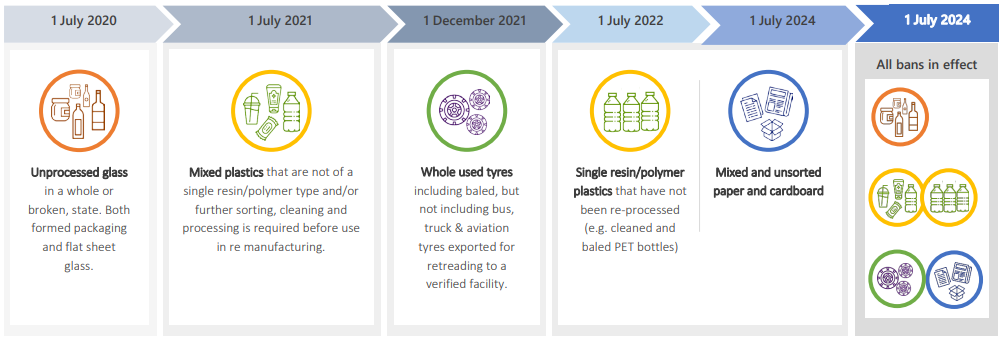War on waste: a new strategy to implement Australia’s waste export ban
14 April 2020
The Council of Australian Governments (COAG) has released a Waste Response Strategy to implement its decision last year to ban the export of waste plastic, paper, glass and tyres, and build Australia’s capacity to generate high‑value recycled commodities.
The COAG’s strategy is a significant step towards Australia’s transition to a ‘circular economy’. The waste export ban and strategy signal a once in a generation transformation of the recycling industry, which is expected to generate $1.5 billion in economic activity over the next 20 years. The waste export ban will commence on 1 July 2020 with a phased approach over a four-year timetable.
Background
Australians create around 67 million tonnes of waste each year, of which 4.4 million tonnes was exported in 2018-19. Around 32 per cent of the total waste export was waste plastic, paper, glass and tyres, with a total declared value of approximately $290 million.
The COAG’s commitment to the waste export ban has been by driven community-level concerns about the impact of waste on our environment and a nation-wide interest in improving resource recovery. Action to address domestic waste processing capacity has also been accelerated by China’s announcement of restrictions on importing recyclable materials under its National Sword Policy in 2018.
The COAG has agreed to establish a timetable to ban the export of waste plastic, paper, glass and tyres in August 2019. A phased approach to implementing the ban aims to create certainty for industry and is predicted to assist reduce further shocks to the waste and recycling sector.
The Commonwealth, State and Territory governments and the Australian Local Government Association agreed this response strategy at the COAG meeting on 13 March 2020. The Strategy is informed by consultation with peak bodies and over 100 individual businesses impacted by the ban and a Decision Regulatory Impact Statement can be found online. The Centre for International Economics also conducted a cost‑benefit analysis of the alternative options to implement the waste export ban, which informed the definitions of materials captured by the ban and supported the need for regulatory action.
The announcement of the ban was followed by the commissioning of an Inquiry into Australia’s Waste Management and Recycling Industries by the Standing Committee on Industry, Innovation, Science and Resources in October 2019, and the release of the National Waste Policy Action Plan in November 2019.
The following sections outline the materials affected by the ban, and the system-level opportunities for government and industry to drive greater domestic waste and recycling capacity.
Material definitions and timing
The definitions and timeframes for materials in scope of the export ban are summarised in the figure below.

Source: COAG Waste Response Strategy
Materials that fall outside the scope of the export ban include:
- Plastics that are:
- sorted into a single resin/polymer type and processed for further use (eg. flakes and pellets); or
- processed with other materials into a product ready for final consumption (eg. manufactured to a specific size and specification and in a form ready for direct use as a fuel in a cement kiln).
- Paper and cardboard that is either:
- sorted to a single type, with low contamination levels;
- processed into pulp; or
- processed with other materials into a product ready for final consumption (eg. manufactured to a specific size and specification and in a form ready for direct use as a fuel in a cement kiln).
- Glass which has been processed into fines or cullet with low contamination levels.
- Crumb rubber, buffings, granules, and tyre shred (<80mm)
System-level challenges and opportunities
The COAG’s strategy acknowledges that driving greater domestic waste and recycling capacity will require action by all levels of government and industry. In consultation, industry participants emphasised the need for system-level changes to build the long-term strength and capacity of Australia’s waste management sector. The COAG’s strategy identifies several opportunities for implementing interventions:
- Addressing waste origins and generation - by minimising the use of single use products and packaging and finding solutions to recycling difficult-to-recycle materials;
- Reducing contaminated kerbside collection - through a combination of recycling education, upgrading material recovery facilities, adopting a simplified and consisted labelling system, and standardised contracting arrangements to align materials accepted by material recovery facilities;
- Driving domestic demand for recycled products - by purchasing recycled products at scale;
- Understanding resource volumes, value and movement - through improved industry reporting beyond the National Waste Report and National Waste Account;
- Investing in new technologies and infrastructure - via co-investment in commercially viable waste and recycling facilities, monitoring competition in the waste, recycling and manufacturing sectors, and factoring in the development of high priority recycling and re-manufacturing facilities in land use planning;
- Coordinating regional recycling capacity - with a focus on establishing regional recycling hubs and coordinating response measures to meet the needs of Northern Australian jurisdictions;
- Driving international cooperation - particularly to manage marine plastic pollution across the Indo-Pacific region;
- Streamlining approval processes and requirements - at a state and territory and local government level, by reviewing potential barriers to waste and recycling related development applications, including opportunities for more risk-based approaches to avoid unnecessary approval delays;
- Considering waste levy settings - to ensure that they are operating to support resources recovery and innovation; and
- Driving product stewardship.
What’s next?
The Commonwealth’s commitments to support the delivery of the waste export ban are expected in the first half of 2020. It is expected that these commitments will include investing in industry innovation and improving waste data capture and tracking of materials.
Thus far, the Commonwealth has expressed an intention to amend the Commonwealth Procurement Rules to ensure Commonwealth agencies consider environmental sustainability and use recycled content as a factor when determining value for money. Additionally, Prime Minister Scott Morrison announced that the Commonwealth will co-invest in critical recycling infrastructure with state and territory governments and industry on a 1:1:1 basis.
Authors

Head of Gender Equality
Law Graduate
Tags
This publication is introductory in nature. Its content is current at the date of publication. It does not constitute legal advice and should not be relied upon as such. You should always obtain legal advice based on your specific circumstances before taking any action relating to matters covered by this publication. Some information may have been obtained from external sources, and we cannot guarantee the accuracy or currency of any such information.
Key Contact
Head of Environment and Planning



